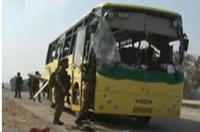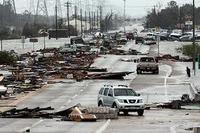-
U.S. working closely with U.K. to secure 2012 Olympics
Yesterday U.S. and U.K. officials met in Washington, D.C. to discuss security plans for the upcoming 2012 Olympic Games in London; the United States will have more than 500 federal agents on hand at the event and is working closely with British authorities
-
-
Internal e-mails reveal FBI confused by Secure Communities

Recently released government e-mails indicate that the FBI had strong doubts about Secure Communities, a controversial DHS immigration program; officials worried that the misunderstanding over whether or not cities and states could actually opt out of the program would lead to a rift between local and federal law enforcement agencies
-
-
DHS warns terrorists targeting buses

In a recent Transportation Security Administration (TSA) security bulletin, officials warned state and local authorities that terrorists are increasingly targeting bus networks; John Pistole, the head of the TSA, explained that bus networks are attractive targets for attacks because of their “accessibility” and their “open architecture”
-
-
Drones and privacy
With civilian unmanned surveillance drones now capable of listening in on cell phone conversations, monitoring Wi-Fi traffic, seeing into backyards and windows not visible from the street, and tracking a person’s movement privacy advocates are concerned that the rapid advances in technology could violate privacy rights
-
-
Plan to protect Houston from the next big hurricane

To protect Houston and Galveston from future hurricanes, experts recommends building a floodgate across the Houston Ship Channel, adding new levees to protect densely populated areas on Galveston Island and the developed west side of Galveston Bay; the team also recommends creating a 130-mile-long coastal recreation area to sustainably use wetlands that act as a natural flood barrier
-
-
DARPA to boost cyber research spending by 50 percent
Last week, the head of the Department of Defense’s advanced research arm announced that the agency would increase cyber research spending by 50 percent over the next five years to develop both defensive and offensive capabilities
-
-
Budget cuts force Nevada to reconsider security priorities
Next fiscal year Nevada will be forced to adapt to a 47 percent cut in DHS funding. To prepare for this new financial reality, Nevada governor Brian Sandoval has called for a reassessment of the state’s homeland security priorities
-
-
$4.1 Million in DHS grants awarded in Kentucky
Kentucky Governor Steve Beshear announced last Thursday that 125 projects will receive approximately $4.1 million in grants courtesy of the Department of Homeland Security
-
-
FTC forces Facbook to change privacy policies
It appears that it will not be too long before Facebook could be forced to get users’ consent every time it wants to make private data available to other members. This will be the result of an agreement Facebook has reached with the U.S. Federal Trade Commission (FTC) over criticism of the social network’s questionable private data policies.
-
-
Good ratings for TV drama "Homeland"
The first six episodes of “Homeland,” the Showtime series focusing on the U.S. fight against terrorism ten years after the 9/11 attacks, have been pulling very good ratings. The series is based on an Israeli drama called “Kidnapped.”
-
-
New Jersey first responders prohibited from taking crash scene photos
New Jersey lawmakers are currently considering a bill that would make it illegal for first responders to take pictures or videos of an accident and distribute them without the permission of the victim’s family; under the proposed law, any first responder who circulates an accident photo or video without permission could face as much as eighteen months in jail or a $10,000 fine
-
-
Training mission showcases Israeli counterterrorism techniques
A group of U.S. law enforcement officials recently concluded a weeklong training seminar on the methods Israel uses to prevent and respond to terrorism
-
-
Israeli defense minister Ehud Barak on Iran, U.S., and war
Israeli analysts note that Prime Minister Benjamin Netanyahu and Defense Minister Ehud Barak have been pushing for a military action against Iran, but that they were thwarted by senior officials in the Israeli national security establishment; with these officials retiring, it appears that Netanyahu and Barak may get their way; On Tuesday, Barak gave a wide-ranging interview to Kol Israel radio station, in which he addressed this and other Iran-related issues
-
-
Majority of Americans willing to use biometric scanners
A recent survey revealed that a majority of Americans are willing to provide their biometric data at airport security checkpoints, during banking transactions, and when receiving government benefits or other services
-
-
Americans anxious about identity theft
Americans will go to great lengths to avoid identity theft, and many say they would take legal action against government or private organizations that compromise their personal data; more than half of surveyed Americans are willing to provide biometric data to secure their identities
-
More headlines
The long view
Factories First: Winning the Drone War Before It Starts
Wars are won by factories before they are won on the battlefield,Martin C. Feldmann writes, noting that the United States lacks the manufacturing depth for the coming drone age. Rectifying this situation “will take far more than procurement tweaks,” Feldmann writes. “It demands a national-level, wartime-scale industrial mobilization.”
No Nation Is an Island: The Dangers of Modern U.S. Isolationism
The resurgence of isolationist sentiment in American politics is understandable but misguided. While the desire to refocus on domestic renewal is justified, retreating from the world will not bring the security, prosperity, or sovereignty that its proponents promise. On the contrary, it invites instability, diminishes U.S. influence, and erodes the democratic order the U.S. helped forge.
Fragmented by Design: USAID’s Dismantling and the Future of American Foreign Aid
The Trump administration launched an aggressive restructuring of U.S. foreign aid, effectively dismantling the United States Agency for International Development (USAID). The humanitarian and geopolitical fallout of the demise of USAID includes shuttered clinics, destroyed food aid, and China’s growing influence in the global south. This new era of American soft power will determine how, and whether, the U.S. continues to lead in global development.
Water Wars: A Historic Agreement Between Mexico and US Is Ramping Up Border Tension
As climate change drives rising temperatures and changes in rainfall, Mexico and the US are in the middle of a conflict over water, putting an additional strain on their relationship. Partly due to constant droughts, Mexico has struggled to maintain its water deliveries for much of the last 25 years, deliveries to which it is obligated by a 1944 water-sharing agreement between the two countries.
How Disastrous Was the Trump-Putin Meeting?
In Alaska, Trump got played by Putin. Therefore, Steven Pifer writes, the European leaders and Zelensky have to “diplomatically offer suggestions to walk Trump back from a position that he does not appear to understand would be bad for Ukraine, bad for Europe, and bad for American interests. And they have to do so without setting off an explosion that could disrupt U.S.-Ukrainian and U.S.-European relations—all to the delight of Putin and the Kremlin.”
How Male Grievance Fuels Radicalization and Extremist Violence
Social extremism is evolving in reach and form. While traditional racial supremacy ideologies remain, contemporary movements are now often fueled by something more personal and emotionally resonant: male grievance.
